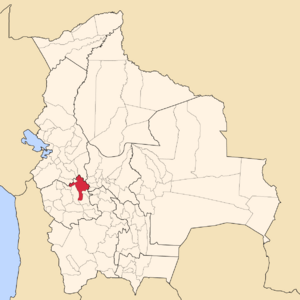Wankarani culture facts for kids

Cercado Province (Oruro), the approximate location of the Wankarani culture
|
|
| Period | Formative stage |
|---|---|
| Dates | c. 1500 BCE - 400 CE |
| Preceded by | Chinchorro |
| Followed by | Tiwanaku |
The Wankarani culture was an ancient group of people who lived in what is now Bolivia. They existed from about 1500 BCE (Before Common Era) to 400 CE (Common Era). This means they lived over 2,000 years ago! They were one of the first groups in Bolivia to settle down and build villages.
The Wankarani people lived in the high plains, called the altiplano, in the Oruro Department of Bolivia. This area is north and northeast of Lake Poopó. Before the Wankarani, people in this area were mostly hunters. But around 1200 BCE, they started to herd animals like llamas. This change helped them live in one place instead of moving around.
Contents
What Was the Wankarani Culture Like?
Wankarani villages were made up of many houses. Some villages had as few as fifteen houses, while others had up to five hundred! Over time, new houses were built on top of old ones. This created small mounds from the remains of mud bricks and trash.
Wankarani Homes and Villages
The houses were small and round. They were made from adobe bricks, which are like sun-dried mud bricks. People painted the outside of their homes red and the inside yellow. When someone died, they were buried right under the floor of their hut.
Most Wankarani villages were small, with fewer than one hundred people. However, some larger villages could have up to 4,000 people. One of the biggest Wankarani villages was found near the Chuquiña village. The mounds where villages were built could grow up to 5 meters (about 16 feet) high. This shows that their way of life stayed pretty much the same for a long time.
A Peaceful Society
The Wankarani people lived in independent village communities. They did not form large kingdoms or states. Their villages were usually built at the bottom of hills. There were no walls around their villages, and very few weapons have been found. This suggests that the Wankarani culture was a peaceful society.
How Did the Wankarani People Live?
The Wankarani economy was based on herding animals and farming. They raised llamas and alpacas. These animals were important for meat, wool, and carrying goods.
Food and Farming
The Wankarani people grew crops like potatoes, quinoa, and qañiwa. The climate in the altiplano is harsh, with little rain. This meant that the Wankarani people mostly grew just enough food to feed themselves. They also traded a little with nearby groups.
Crafts and Skills
The Wankarani people knew how to work with copper. They had smelters, which are special ovens used to melt metal. Artisans, or skilled craftspeople, also made small stone heads. These sculptures looked like llamas and alpacas.
Wankarani pottery was quite simple. It did not have many decorations. This makes it a bit harder for us to understand their artistic style.
The End of the Wankarani Culture
The Wankarani culture eventually came to an end. It was slowly taken over by the growing and powerful Tiwanaku Empire. The Tiwanaku empire became a very important civilization in the Andes region.
Other Cultures at the Same Time
The Wankarani culture was not the only one around during its time. In northern Chile and parts of Peru and Bolivia, other cultures also started to use pottery. These included the 'Faldas del Morro' and 'Alto Ramírez' cultures. The Alto Ramírez phase, for example, existed from about 1000 BCE to 400 CE. This means it was around at the same time as the Wankarani culture.
Other cultures that lived around the same time near Lake Titicaca included Pukara, Qaluyu, Chiripa, and early Tiwanaku.
See also
 In Spanish: Cultura wankarani para niños
In Spanish: Cultura wankarani para niños

